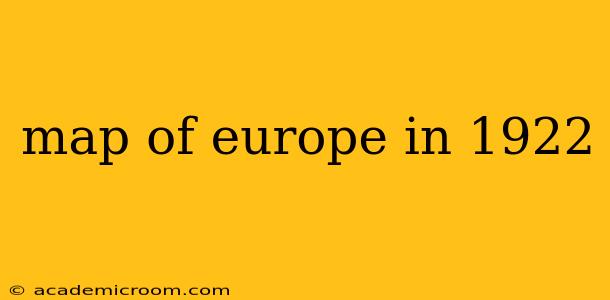1922 marked a pivotal year in European history, a period of significant political and territorial reshaping in the aftermath of World War I. Understanding the map of Europe at this time requires acknowledging the profound changes wrought by the Treaty of Versailles and the subsequent redrawing of national borders. This post will delve into the key features of the 1922 European map, addressing common questions and providing context for this complex and fascinating period.
What did Europe look like in 1922?
The map of Europe in 1922 was dramatically different from its pre-war counterpart. The collapse of the Austro-Hungarian Empire and the Ottoman Empire resulted in the creation of numerous new nation-states, while existing countries experienced significant boundary shifts. The newly formed nations of Czechoslovakia, Yugoslavia, Poland, and the Baltic states (Estonia, Latvia, and Lithuania) held prominent positions on the map. The map also reflected the significant territorial losses suffered by Germany, Austria, Hungary, and Russia, resulting in a complex mosaic of borders and shifting power dynamics. Areas like the Rhineland were under Allied occupation, further illustrating the unstable nature of the post-war European order.
Which countries existed in Europe in 1922?
Many familiar countries existed in 1922, but their borders and political situations differed greatly from those of today. Established powers like Great Britain, France, Italy, and Spain remained, but their roles on the world stage were evolving. The newly created states mentioned above added significant complexity to the map. Russia, in the throes of the Russian Civil War, was a vastly different entity than it is today. The Ottoman Empire was significantly diminished, its European territories largely carved up and incorporated into other nations or placed under international mandate. It's crucial to note that the political landscape within these countries also varied widely, with some experiencing relative stability while others battled internal conflicts and political instability.
How did the Treaty of Versailles change the map of Europe?
The Treaty of Versailles, signed in 1919, was the cornerstone of the post-war redrawing of Europe. It dictated the territorial losses of Germany, including Alsace-Lorraine's return to France and the loss of significant territories in the east. The treaty also established the League of Nations, designed to prevent future conflicts, but its effectiveness would later be debated. The treaty's impact on the map was profound and far-reaching, setting the stage for future conflicts and resentments.
What territories were disputed in Europe in 1922?
Several territories remained contested even after the Treaty of Versailles. The status of some border regions, particularly those involving newly created states, remained uncertain, leading to lingering disputes and territorial claims. The instability in Russia, marked by ongoing civil war, also resulted in uncertainty over its eastern borders. This period of boundary disputes, in tandem with economic hardship and political instability, contributed to the volatile conditions of the 1920s in Europe.
Did the map of Europe change significantly after 1922?
While 1922 represented a relatively stable point compared to the immediately preceding years, the map of Europe continued to evolve. The subsequent years saw further adjustments in the Balkans and Eastern Europe, along with continued tension between the newly established countries and their neighbors. The rise of fascism and Nazism in the interwar period further destabilized the existing order, ultimately leading to the outbreak of World War II and another major redrawing of the European map.
Understanding the map of Europe in 1922 requires a detailed look beyond simple borders. It was a map etched with the scars of a devastating war, a testament to the complexities of nation-building, and a harbinger of the escalating tensions that would lead to another global conflict. The period serves as a critical case study in the intertwined dynamics of geopolitical shifts, national identities, and the enduring challenges of peacemaking after major wars.
